The founders of Nuvolari Lenard — Carlo Nuvolari and Dan Lenard—embrace transformation and actively pursue it. Transformation is the catalyst for pushing the boundaries of design language and the bridge that unites aesthetics with practicality.
To many onlookers, the exterior of a yacht is the first impression, and the elegant, streamlined curves hint at the yacht’s progressive design. This domain is one the Nuvolari Lenard crew is intimately familiar with, having crafted some of the most renowned yachts of our time, including the 141.6-meter Nord, the 115-meter Ahpo, and the 60.3-meter Comfortably Numb, among others, while also pioneering new standards with inventive designs like the 202-meter Centrefold, or the NLPlus, which embodies the quintessential superyacht in just 52 meters.
Dan Lenard points out that the exterior is just one piece of the design puzzle, with its connection to the interior’s layout and aesthetic being fundamental. With his recent role as the head of the studio’s interior design department’s art direction, he’s focusing on enhancing the interaction between form and function while also revitalizing the core of what an interior space can achieve.
“A yacht,” Dan Lenard explains, “is to be conceived as a whole, and separating external design from internal design reduces the possibility of elevating the entire yacht project to a higher level – that is, to that of a work of art.”
It’s all part of that continual strive to change, to look ahead, and to rejuvenate the team’s way of designing, and it’s becoming more and more essential as owners’ own attitudes change, both in terms of style and in terms of environmental considerations. “We clearly perceive the expectations of today’s shipowners who, regardless of their age, think differently and think younger,” offers Nuvolari. “The covid pandemic marked the change to a new era – interior design in recent years has often seen appearance dominate substance and excess in the use of special (as well as expensive) materials. ”
“We want to reverse this equation,” he continues, “with a trend that will see the exaltation of true design, less formality in environments, less emphasis in decoration, and interior design focused entirely on the individual and wellbeing.”
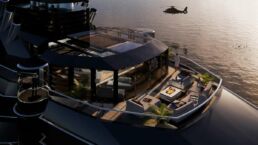
To accomplish this essential change, the team at Nuvolari Lenard is concentrating specifically on two critical aspects: paying close attention to scale and carefully planning the design and application of light. “This is where the connection with the exterior design shows itself,” Lenard
explains, “because the emphasis on light influences the relationship with the yacht’s exterior design which determines the shape and position of the windows.”
A case illustrating this progressive move towards a novel trend is the Orangerie within the Centrefold project – a location that harmonizes with its surroundings, characterized by a predominant focus on light and vision, featuring a minimalist aesthetic that avoids going too formal or adding too much decoration. The area is primarily filled with large expanses of glass, enclosing the space from the ground up and extending above. “It’s a living space on the yacht where visitors are made to experience the feelings and sensations of being outdoors,” says Lenard.
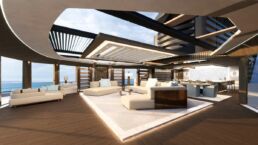
Alongside this new perspective on interior design, another critical factor emerges – the aim for improved environmental sustainability and enhanced customer satisfaction. This aspect is a second motivating factor in Nuvolari Lenard’s fresh approach to interior design.
Nuvolari, in particular, has emphasized this area, highlighting the impacts of various materials and methods employed in interior construction. This, in turn, allows him to provide shipowners with detailed information to explain these elements and assist them in making informed decisions.
“Often,” he says, “we tend to consider materials as ‘sustainable’ that actually only have the appearance of being sustainable, and other times we condemn the use of other materials only because we have limited – or tradition-distorted – information.”
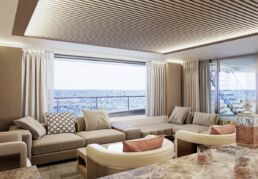
For instance, Nuvolari highlights the use of natural leather. “We often criticise its use, preferring synthetic leathers,” he says, “but we forget that it is a by-product of the food industry that, if not used, would have to be disposed of with a serious impact on the environment.”
These instances are abundant, and that’s why Nuvolari Lenard requests details and information from its suppliers regarding the source of materials and the methods employed in their production to choose more eco-friendly ones.
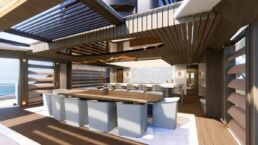
The group is expanding its focus on environmental factors by also looking at the impact of volatile organic compounds (VOC) and the emission of harmful chemicals in the interior of yachts that continue to affect the environment even after the yacht is handed over. This is crucial as these substances can affect the air’s quality, a topic of ongoing debate in civil engineering but has not received much attention in the yachting industry yet. Nuvolari Lenard carefully explores building methods and materials that counteract these adverse impacts on interior construction firms.
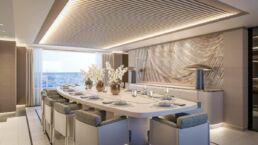
SHARING IS CARING - THANK YOU!
About Publisher
 Ahoy, I’m René, the “captain” of this luxury yacht blog, and found my passion for the big ones at the age of 17. I have grown up with sailing since a little child. I have an education in Business Informatics and specialized in digital media solutions (alongside luxury yachts) like Online-Marketing, User Experience Design et cetera. My home port is in Oldenburg, Germany next to Lürssen and Abeking & Rasmussen. More about yachtemoceans
Ahoy, I’m René, the “captain” of this luxury yacht blog, and found my passion for the big ones at the age of 17. I have grown up with sailing since a little child. I have an education in Business Informatics and specialized in digital media solutions (alongside luxury yachts) like Online-Marketing, User Experience Design et cetera. My home port is in Oldenburg, Germany next to Lürssen and Abeking & Rasmussen. More about yachtemoceans